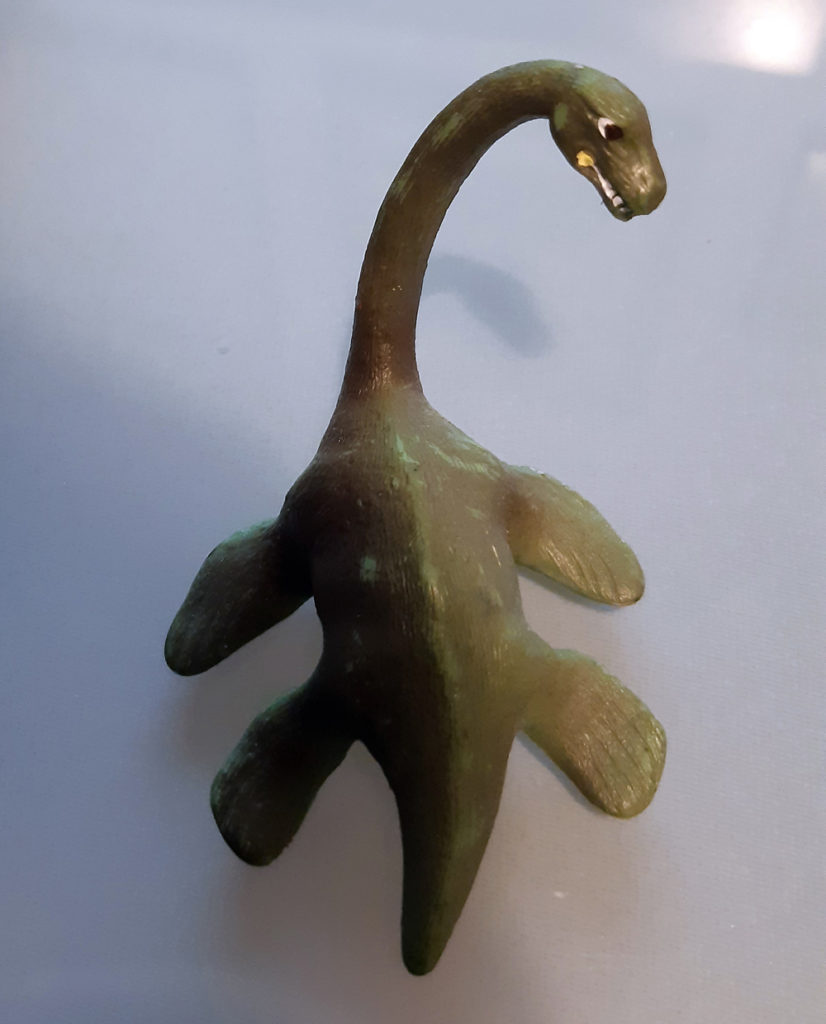Review and photographs by Funk, edited by Suspsy
To the general population, plesiosaurs are mainly known as “that prehistoric animal which the Loch Ness Monster might be,” though they were, of course, a very distinct group of reptiles with a long and important role in the history of palaeontology. Plesiosaurus itself was the first named plesiosaur, lending its name to the group, and could be said to be the archetypal member. The genus also has a long history in palaeoart, being included in many of the first artworks reconstructing prehistoric life, such as the famous Duria Antiqior, which depicted Plesiosaurus along with many other fossil animals discovered by the pioneering fossil hunter Mary Anning.

Prehistoric animal toys have a tendency to mimic trends in palaeoart, and this is certainly true for the plesiosaurs, which were invariably depicted with overly flexible swan or snake-like necks until that idea finally fell out of favour. Straighter necks with limited flexibility are now thought more likely. This Plesiosaurus figure by the German company Bullyland is from 1986, and thus inevitably periscopes its neck upwards in the classic posture.
The genus Plesiosaurus has historically been a bit of a wastebasket taxon, with many species lumped into the genus until finally being moved to their own genera. What remains is the type species, P. dolichodeirus, and it could be assumed that the figure depicts that species. However, there is something distinctly “Nessie-esque” about it, and the posture particularly looks like a famous Nessie painting by Gino D’Achille, though it is possible that this art was itself based on a depiction of Plesiosaurus. It’s a bit of a “chicken and the egg” situation.

The Nessie-like features include the strangely mammalian head; with those big, forward-facing dark eyes, it almost looks like a seal, coupled with those lines running backwards from the eyes which makes the plesiosaur look more cute and cuddly than your average reptile. Furthermore, it has striations all over the body which look like swept-back fur more than any kind of scales or wrinkles. The flippers also have lines that look like those seen on seal flippers, which correspond to where the underlying fingers connect. Is this actually a Nessie toy in disguise as a more respectable plesiosaur one? Hard to say, as by the time of this toy’s release, the Nessie myth had merged with the concept of plesiosaurs in the public mind.

It should be clear by now that the toy is not exactly an accurate depiction of Plesiosaurus. Its skull has been known for more than 150 years, yet the head of the toy really doesn’t look much like it. While the head of Plesiosaurus and other plesiosaurs was flattened from top to bottom, with the eyes placed relatively far to the front and close to the top of the skull and the nostrils directly in front of them, the head of the toy is rather tall and flattened from side to side, with the eyes placed on the sides, and the nostrils are placed at the front of the snout. In addition to the neck having been much straighter in life, there is evidence that at least some plesiosaurs had tail flukes, which doesn’t seem to have been widely acknowledged at the time, and isn’t shown on the toy. But in general, the proportions seem to more or less match those of P. dolichodeirus (though it could possibly be based on one of the many other species which were previously also placed in that genus).

Moving on to the colouration, the figure is military green overall and darker on the back, where it seems to be painted on (other variants with different greens exist). The eyes are white with black pupils, and look much larger than what the shape of the sculpted eyes would indicate due to the paint being somewhat splashed out. The teeth are represented by straight, white lines of paint, arranged in even rows, whereas Plesiosaurus would have had interlocking teeth in a much more irregular arrangement. Another strange paint feature of the head is the presence of yellow splotches at the corners of the mouth; I have never been able to figure out what these were supposed to indicate.

In conclusion, this toy is a pretty cute retro plesiosaur, and could also be a good contender for someone looking for a Nessie toy. It is hardly accurate by modern standards, and hardly even for the standards of 1986 given the weird head shape. I got this toy at a museum as a kid, and though it is older than I am, and even joined me in the bathtub more than a few times, it is in pretty good condition. So if you can find it for sale, chances are good it will be rather well-preserved.
Disclaimer: links to Ebay and Amazon on the DinoToyBlog are affiliate links, so we make a small commission if you use them. Thanks for supporting us!



